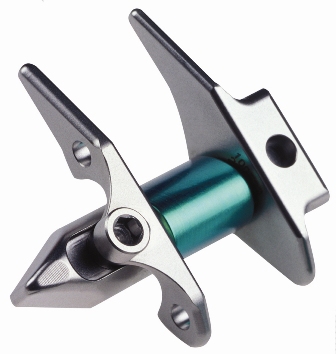NYM Offers Innovative Solution to Treat Lumbar Spinal Stenosis
Jan 22, 2009

The X-STOP device is designed to remain safely and permanently in place without attaching to the bone or ligaments in your back.
A new minimally invasive surgical procedure that relieves the symptoms associated with lumbar spinal stenosis (narrowing of the spinal canal) is now available at New York Methodist Hospital (NYM).
Lumbar spinal stenosis (LSS), which primarily affects individuals over the age of 50, often results from bone overgrowth that places pressure on spinal nerves, in turn causing pain and/or discomfort. Persons with LSS often find that the disease limits daily activities like walking and standing, which increase the symptoms of spinal stenosis. Symptoms associated with spinal stenosis include dull or aching back pain that spreads to the legs, weakness or loss of balance, and numbness and "pins and needles" in the legs, calves or buttocks.
In the United States, LSS is the primary reason for back surgery in people over the age of 65. The most common type of surgery to treat stenosis (laminectomy) requires the removal of various parts of the vertebrae, leaving a part of the spinal cord exposed. The operation takes approximately two hours.
The X-STOP IPD, the new procedure now being performed at New York Methodist Hospital, involves placement of an implant, called the X-STOP device, between two bones in the back of the spine to widen the canal and alleviate the symptoms of spinal stenosis. Once the implant is in place, the bone overgrowth no longer comes in contact with the nerves and the symptoms are alleviated. This new procedure decreases the risks of medical complications associated with traditional surgery used to treat LSS and can be performed in under an hour with the use of local anesthesia.
"Patients who undergo this procedure are able to go home the very same day instead of spending a few nights in the Hospital to recover, as they would with traditional surgery" said Martin Zonenshayn, M.D., chief of neurosurgery at NYM, who performs the procedure. According to Dr. Zonenshayn, a good candidate for X-STOP is a patient whose physical function is moderately impaired or one who might not be able to undergo traditional surgery because of health reasons.
New York Methodist will host a free patient educational seminar to help people suffering from spinal stenosis understand the condition and how to manage it. This is an opportunity for LSS patients to learn about treatment options, including non-surgical therapy, traditional surgery and X-STOP. The seminar will be held on Monday, March 23, 2009, at 6:30 p.m. in the Hospital's Executive Dining Room. To register or for more information, please call 718 780-5367.


